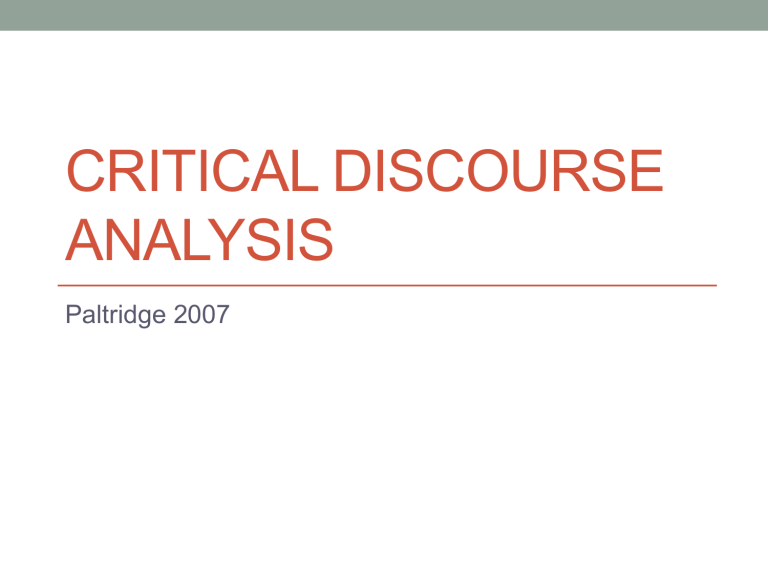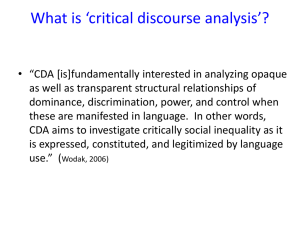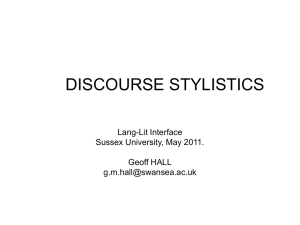CrITIcal DIScourse AnalysIS

CRITICAL DISCOURSE
ANALYSIS
Paltridge 2007
What is critical discourse analysis (CDA)?
• Hyland (2005:4) acts of meaning making are always engaged in that:
• they realize the interests
• the positions
• the perspectives
• the values of those who enact them
The aim of CD is help reveal some of the hidden values , positions and perspectives .
CDA examines the use of discourse in relation to social and cultural issues , such as race, politics, gender, identity and asks why the discourse is used in particular way and what the implications are of this kind of use .
What is CDA?
• CDA assumes that
• language use is always social
• discourse both reflects and constructs the social world
• A critical analysis explores issues such as gender, ideology and identity and how these are reflected in particular text
• To do CDA, the first step is analysis of the use of discourse, the second step is explanation and interpretation of the discourse. The final step is deconstruction of the text, tracing ideologies and assumptions underlying the discourse and link them to different views of world, experience and beliefs.
Principles of CDA (Fairclough and Wodak,
1997)
• Social and political issues are constructed and reflected in discourse
• Power relations are negotiated and performed through discourse
• Discourse both reflects and reproduces social relations
• Ideologies are produced and reflected in the use of discourse
Social and political issues are constructed and reflected in discourse
• Singapore ’s “Speak Mandarin” campaign (Teo, 2005)
• The aim of the campaign:
•
• to connect Chinese Singaporeans with Chinese cultural traditions.
To help counter “negative effects of westernisation.
• To attract foreign investment, especially from China
Headlines:
Mandarin: Window to Chinese Culture
Speak Mandarin, It ’s an asset
Speak Mandarin: Your Childern ’s Future Depends on You
• Cool and contemporary relevance of Mandarin
• The discourse of campaign constructs the view of
Mandarin as a language that has both social, cultural, and economic value for the people of Singapore .
Power relations are negotiated and performed through discourse
• Conversational interaction: who controls conversational interaction, who allows the person to speak, how they do this.
• Radio show: caller-host
• Callers-set the opinion on the line
• Hosts- challenge the opponent to expand on and account for their claims (e.g., yes? So)
Discourse both reflects and reproduces social relations
• Social relations are both established and maintained through the use of a discourse.
• Tony Blair ’s wife Cherie Blair in the media: a lawyer, a wife, a working mother and establish a relationship between her and public and especially other working mothers.
• Presentation in media: A success story of Cherie Blair for managing her role as a working mother-negative terms for working mothers shift to different views of women with children who work.
Ideologies are produced and reflected in the use of discourse
• Representing and constructing society, such as relations of power , relations based on gender , class and ethnicity .
•
•
Brewster (2005)- negative attitudes towards non-standard social dialects of English negative views of the people who are speaking non-standard dialects
Mallinson and Brewester US restaurant workers ’ view of customers / white workers view black customers in negative terms. They use streotypes to form their expectations about future interactions to black customers and other African-Americans.
• Discourse of difference (Wodak, 1997): speaking in black customers and distancing themselves from them.
Ideologies are produced and reflected in the use of discourse
• The workers ’ use of discourse privileged their own race and social class, reflecting their ideological, streotyped views of both groups of customers.
• CD studies aim to make connection between social and cultural practices and the values and assumptions that underlie the discourse .
• They try to reveal what people say and do in their use of discourse in relation to their views of world, themselves and relation of each others.
• CD maintains that the relationship between language and meaning is never arbitrary in that the choice of particular genre or rhetorical strategy brings with it particular presuppositions, meanings, ideologies and intentions.
• Example: complaining about your neighbour
• Choose an appropriate genre:
• neighbourhood mediation session
• complaint in a televison chat show
Example: compalint about a single mother > others ’ prejudice against single mothers> our own biases and moral judgments about them as an added rationale for complaining about the neighbours.
Key focus in critical discourse studies
• To unite text with the discourse and sociocultural practices that the text reflects, reinforces and produces.
• Discourse simultaneously involves each of the following dimensions:
Texts > discourse practices > sociocultural practices
Doing CDA
• Decide discourse type or genre
• Consider the frame of the text- perspective
• foregrounding — emphasized issues
• Backgrounding — played down topics
• Deal with topicalization at the sentence level
• Determine connotations of particular words and phrases
• Identify the words which express degree of certanity and attitude






